|

WATER
CONTAMINATION - A planning application that was received in September
2018, is in connection with one of the most controversial grants ever to
be made under the dubious lead of Kelvin Williams and Charlie Lant, both
officers now ousted from their former positions in Wealden District
Council.
The
problem now for those who are left to pick up the pieces, is how to give
the developers something for their efforts without breaking
Environmental laws or becoming a party to criminal pollution from future
users of the proposed houses, that is beyond their control and where
conditions would be unenforceable - as would doubtless be part of any
claim in damages from those affected by the inevitable pollution.
If houses are built on the hill
at Lime Cross, that supplies the last
surviving well in Herstmonceux, all of those who presently enjoy a
sustainable water supply from the oldest working well in the village are likely to be poisoned by pesticides from a
number of the
gardens of the proposed housing - at the moment that looks like being 28
units positioned directly above and in the groundwater soakage line of fire. In addition, where the hard standings of
the proposed 70 houses are to be gully drained to a point lower than the
twin wells, rainwater soakage that supplies the wells will be diverted away
potentially starving the wells of water, save that from the garden areas
that are impossible to gully.
The amusing cartoon above portrays the situation that perhaps the
developers were not aware of, when they bought into a situation that they
should have been able to rely on.
Unfortunately, the council concerned and
the advisers to the original applicants appear to have been less diligent
than they might have been, possibly caught up in the rush to profit from a windfall situation.
The question that is probably on your lips is: "Was that an
oversight, or was it deliberate"? Five of the councillors giving
consent in 2015 are still on the APS committee in 2018, while seven are
newcomers. Those who served previously will now be faced with new
information that was not given to them when that Committee voted by one
to give consent. The incoming Members will have a lot to grapple with to
catch up but may find that the issues have been distilled from the large
number of objectors who are concerned about village over-development
with insufficient services and protections.
Information
that was not provided by the then vendor, Tim
Watson, or Developer Gleeson
Developments may be laid at their foot, for the onus was on them to
survey the land properly in relation to any potential contamination.
There can be no doubt that Gleeson and their advisers knew of the wells
in Lime Park, just as they knew that surface water run off through the
private ponds would lead to flooding and was beyond their control.
Though, this information appears not to have found its way to Latimer
Developments, Thakeham
Homes or the Clarion
Housing Group - or maybe it has and they simply do not care.
Another
problem that is rearing it's head with many developments is that
corporations are building what they want to build without constructing
the affordable unit quotient or making improvement to drainage and
access roads that some council's have been kind enough to overlook at
the grant stage with a promise from developers to overcome, when in fact
those developers simply vanish without trace, leaving nobody to pick up
the tab for the breaches of contract they have engineered. In other words development is never completed to a stage where
flooding and other contamination measures are safe.
In
addition, the Pevensey and Cuckmere Water Level Management
Board concluded that the developer's water management ‘strategy’ was certain to result in flooding on site and off site (in Lime Park) because the pipes into the ponds are far too small/not designed for heavy duty runoff, and there are legal obstacles to changing them.
Building in yet more water pollution issues, but this time at the other
end of the field, where the developer has proposed dealing with surface
water through a pond not under the control of the developer, so leaving
the developer unable to provide what is required in law if such
application if granted.
These
are issues that we are sure would cause concern to the Secretaries of
State for the Environment (Michael
Gove), Housing (James
Brokenshire), Culture (Jeremy
Wright) and the Prime
Minister, where Theresa
May is quoted as being concerned at the housing shortage from years of
lackluster performance from developers and local authorities. That said,
cutting corners that will lead to future complications is not the way to
fill the financial void from central Treasury cuts, even if Liz
Truss believes otherwise.
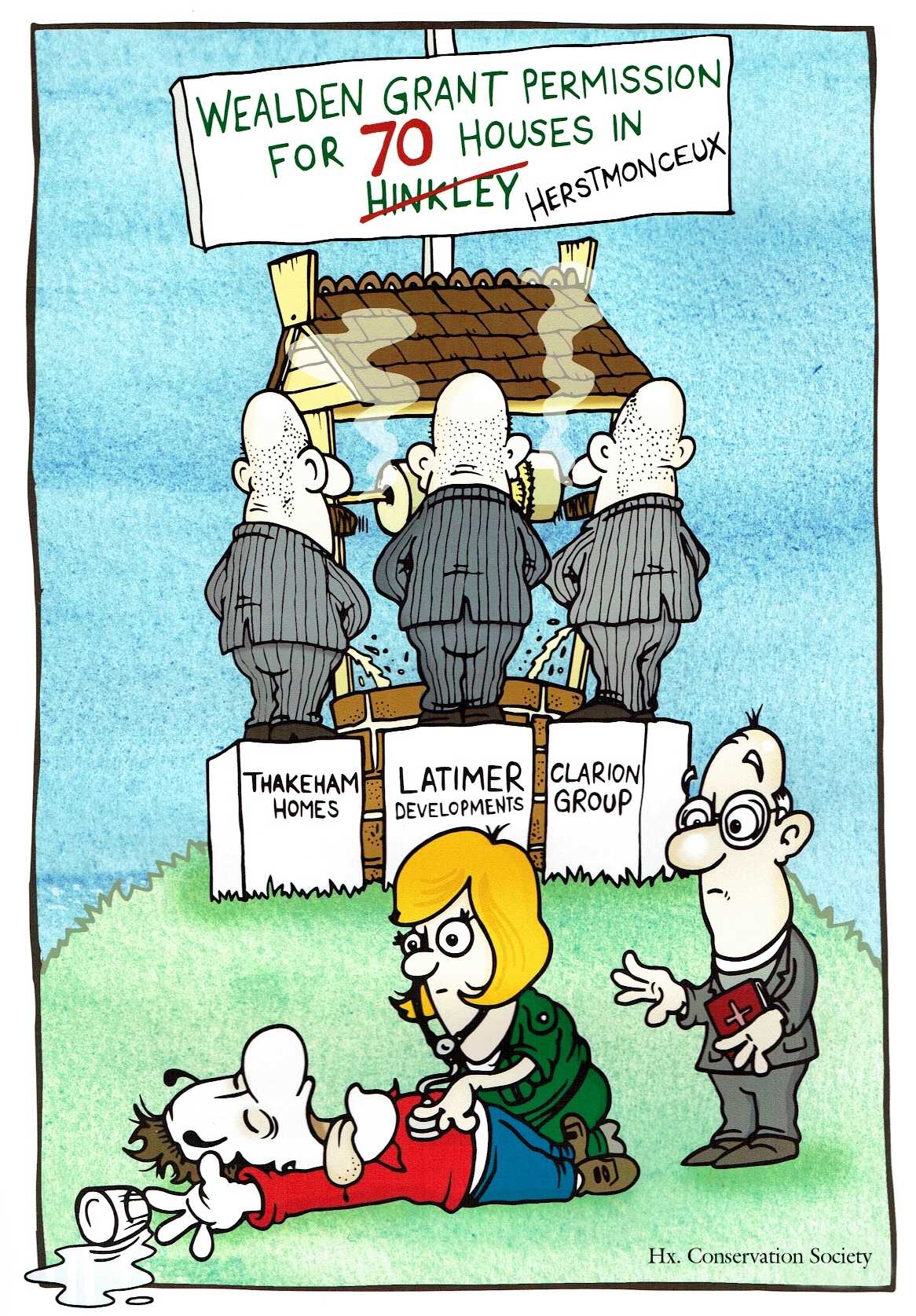
COUNCIL
MEMBERS SITTING ON - AREA PLANS SOUTH 2018
Dick Angel - Firlands House, Mutton Hall Hill, Heathfield, East Sussex, TN21 8NL
Kevin Balsdon - 10 The Belfry, Hailsham, East Sussex, BN27 3UG
Bob Bowdler - Iron Latch Farm, Forest Lane, Punnetts Town, TN21
9JA
Dianne Dear - 37A Eastbourne Road, Pevensey Bay, East Sussex, BN24 6HL
Richard Grocock - Camelot, Western Road, Hailsham, East Sussex, BN27 3DY
Douglas Murray - 69 Wannock Lane, Willingdon, Eastbourne, East Sussex, BN20 9SG
Amanda O'Rawe - 40 Sandbanks Way, Hailsham, East Sussex, BN27 3LN
Angela Snell - 11 Elizabeth Court, High Street, Polegate, BN26 5EN
Stephen Shing - 18 Coppice Avenue, Willingdon, Eastbourne, BN20 9PN
Susan Stedman - Tubwell Nurseries, Tubwell Lane, Maynards Green, Horam, East Sussex, TN21 0BY
Chriss Triandafyllou - Hillcrest, Coldthorn Lane, Hailsham, East Sussex,
BN27 3PJ
David Watts - Ashridge, 28 Sunstar Lane, Polegate, East Sussex, BN26 5HS
RESERVES
Councillor
Jo Bentley (Reserve)
Councillor Nigel Coltman (Reserve)
Councillor Jan Dunk (Reserve)
Councillor Johanna Howell (Reserve)
Councillor Daniel Shing (Reserve)
Councillor Roger Thomas (Reserve)
APS EMAILS 2018
Angel,
Dick - cllr.dick.angel@wealden.gov.uk
Balsdon,
Kevin - cllr.kevin.balsdon@wealden.gov.uk
Bowdler,
Bob - cllr.bob.bowdler@wealden.gov.uk
Diane
Dear - cllr.dianne.dear@wealden.gov.uk
Grocock,
Richard - cllr.richard.grocock@wealden.gov.uk
Murray,
Douglas - cllr.douglas.murray@wealden.gov.uk
O'Rawe,
Amanda - cllr.amanda.orawe@wealden.gov.uk
Snell,
Angela - cllr.angela.snell@wealden.gov.uk
Stephen
Shing - cllr.stephen.shing@wealden.gov.uk
Susan
Stedman - cllr.susan.stedman@wealden.gov.uk
Triandafyllou,
Chris - cllr.chriss.triandafyllou@wealden.gov.uk
Watts,
David - cllr.david.watts@wealden.gov.uk
Support officer: Sarah Lawrence, Democratic Services Officer
Tel: 01892
602720
Email:
committee.services@wealden.gov.uk.
Stacey Robins, South Team Leader, Tel: 01892 602518

WHAT
ACCESS? -
Would you believe that this is the proposed access for a site where 70
houses are to be serviced, meaning around 200 car entry and exit
movements per day. The car seen here is just about to go up the
hill that has another development on the other side of the road, leading
down into the village. The cumulative effect of additional housing all
over Sussex is wearing our roads much
quicker without the funding to repair them leading to dangerous potholes
that catch our cyclists and damage vehicles. Hardly sustainable in United
Nations terms, and is likely to lead to what amounts to Corporate
Manslaughter charges should there be a fatality at this location
arising from a breach of any of the corporation's duty of care failures.
What is needed is new
roads that serve new housing developments, not old networks that cram
multiple entrances onto what would be classed as substandard roads. That
is short sighted planning the hallmark of Pothole
Politics, that many councils are guilty of through long term mismanagement.
AREA PLANS SOUTH 2018
- PLANNING COMMITTEE
|

Councillor
Dick Angel
|

Councillor
Kevin Balsdon
|

Councillor
Bob Bowdler
|

Councillor
Dianne Dear
|
|

Councillor
Richard Grocock
|

Councillor
Douglas Murray
|

Councillor
Amanda O'Rawe
|

Councillor
Angela Snell
|
|

Councillor
Stephen Shing
|

Councillor
Susan Stedman
|

Councillor
Chriss Triandafyllou
|

Councillor
David Watts
|
APS
RESERVES - PLANNING COMMITTEE
|

Councillor
Jo Bentley
|

Councillor Nigel Coltman
|

Councillor Jan Dunk
|
|

Councillor Johanna Howell
|

Councillor
Daniel Shing
|

Councillor Roger Thomas
|
COUNCIL
MEMBERS SITTING ON - AREA PLANS SOUTH IN 2015
Andrew
Long - (no email address)
David
White - cllr.david.white@wealden.gov.uk
Diane
Dear - cllr.dianne.dear@wealden.gov.uk
Charles
Peck - cllr.charles.peck@wealden.gov.uk
Chris
Hardy - cllr.chris.hardy@wealden.gov.uk
Chris
Triandafyllou - cllr.chriss.triandafyllou@wealden.gov.uk
Daniel
Shing - daniel.shing@wealden.gov.uk
Dick
Angel - cllr.dick.angel@wealden.gov.uk
Barby
Dashwood-Morris - cllr.barby.dashwood-morris@wealden.gov.uk
Barry
Marlowe - cllr.barry.marlowe@wealden.gov.uk
Bill
Bentley - cllr.bill.bentley@eastsussex.gov.uk
John
Blake - cllr.john.blake@wealden.gov.uk
Lin
Clark - cllr.lin.clark@wealden.gov.uk
Nigel
Coltman - cllr.nigel.coltman@wealden.gov.uk
Nigel
McKeeman - cllr.nigel.mckeeman@wealden.gov.uk
Raymond
Cade - cllr.raymond.cade@wealden.gov.uk
Robert
Standley -
Ron
Cussons - cllr.ron.cussons@wealden.gov.uk
Stephen
Harms - cllr.steve.harms@wealden.gov.uk
Stephen
Shing - cllr.stephen.shing@wealden.gov.uk
Susan
Stedman - cllr.susan.stedman@wealden.gov.uk
LIFE
THREATENING ROADS
It's
a blooming miracle that there are not more accidents. Every time you
swerve to avoid damaging your suspension, you are making a maneuver that
could lead to trouble. if you don't take avoiding action, then you will
be damaging your tyres as they impact the sharp lip of these tarmac
craters. That may not puncture your tyre right away, but with every
similar encounter the construction of your rubber interface with our
flexible road surfaces is weakened. Eventually, the carcass will give
way and you will not be able to pinpoint the cause.
What
happens if your tyre blows and cause your vehicle to swerve and hit a
pedestrian or cyclist. How will you feel if you run over a child or
pregnant woman, or a pensioner who is on their way back from the shops -
expecting a safe return home.
You
will be the one feeling bad or being prosecuted - not the state. It
should be the other way around. The State should be prosecuted for
negligence and in some cases: murder
and under the new legislation the Crown departments, local authorities
and the developing corporations may be joint defendants in a prosecution.
ROADS
- Potholes in roads are not only dangerous, but also soak up energy with
every bump that hinders progress. Pothole
Politics is the name for policies that fail to address climate
change (sustainable society) issues, but may apply to our pathetic
record on adapting to meet the challenges ahead. How can we aim to
better ourselves if we cannot even maintain the roads we have.
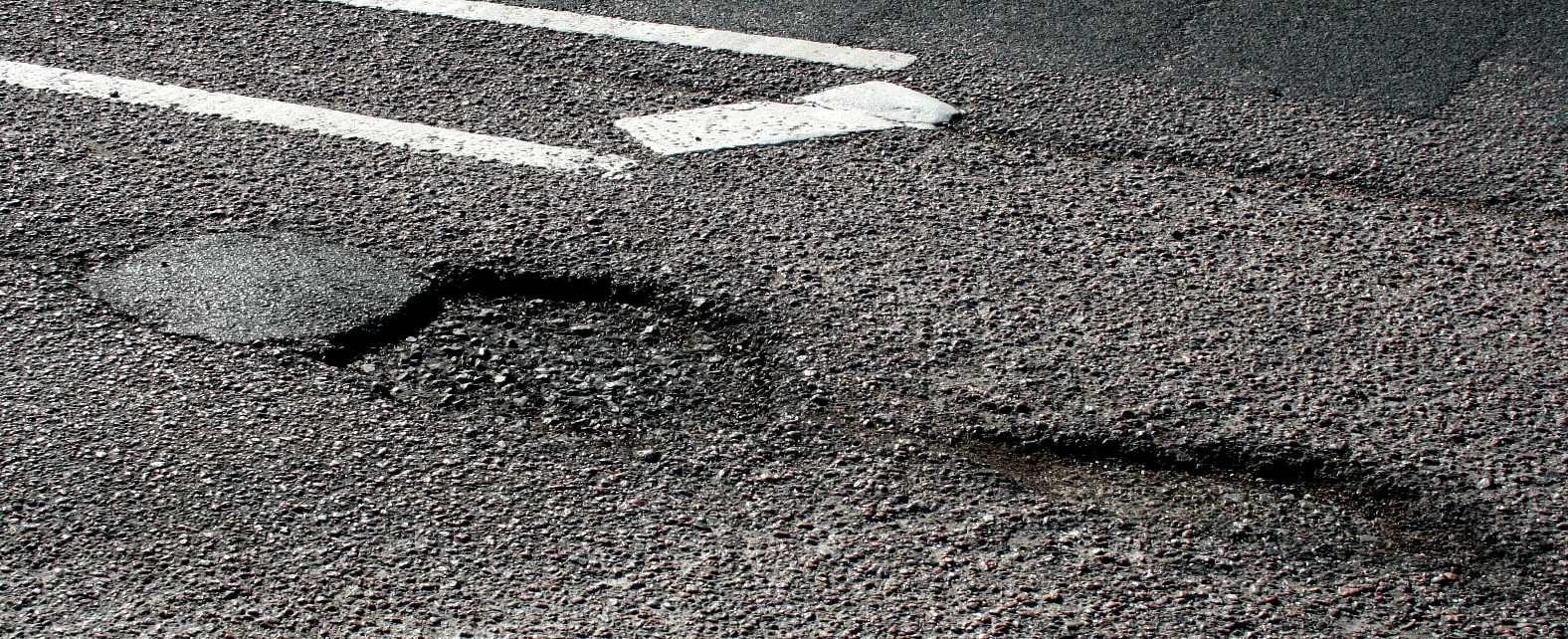
REPAIRED
ONCE ALREADY - Not a bad blend
in that one, pity it didn't last. This wear and tear may do better with
a stronger repair compound. Who monitors the quality of the tarmac we
use on our roads. Should not high traffic areas have a different mix to
cope without constant repair after repair. Is there not a high speed
repair machine? We certainly need one. The real problem is that we are
overloading our existing road network with more traffic than it was
designed for. The result is more wear with councils spending less on
creating the infrastructure that is needed to cope because they are
overspending elsewhere.
Building
more affordable houses, rather than those for rent at prices much higher
than buying on a low mortgage, is one way that councils could begin to
balance out their budgets. Affordable flatpack homes is one answer, with
land capped in value to bring down the build costs even further. That
would of course require councils or central Government to buy up
strategic farmland via compulsory purchase.

WD/2015/0090/
HERSTMONCEUX VILLAGE CONDITIONS A - Z INDEX
NPPF
- NATIONAL PLANNING POLICY FRAMEWORK A - Z INDEX
PRIME
MINISTER, SECRETARIES OF STATE & MPs 2018
|

Theresa
May - Prime
Mnister
MP
for Maindenhead
|

Michael
Gove
MP
Surrey Heath
|

James
Brokenshire
MP
Old Bexley & Sidcup
|
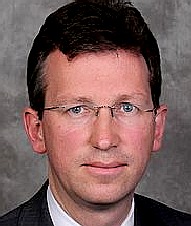
Jeremy
Wright
MP
Kenilworth & Southam
|
|
|
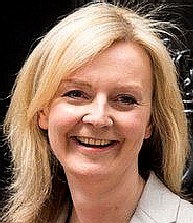
Liz
Truss
MP
South West Norfolk
|

MP
Nus
Ghani
MP
Wealden
|
|
LETTER
FROM HERSTMONCEUX MUSEUM LTD 25-09-18
F.A.O. Cllrs Area Plans South Committee SPECIAL POST
Wealden District Council
Vicarage Lane
Hailsham, BN27 2AX
25 September 2018
Dear Member,
PUBLIC WATER SUPPLY – ENVIRONMENT & HERITAGE
PLANNING APPLICATIONS Nos: WD/2015/0090/MAO & WD/2018/1584/MRM
Please find enclosed copy of our letter dated September 24 2018 to: Rt Hon
Michael Gove MP, the Secretary of State for the Environment.
We would drawn your attention to the site plan relating to the above applications and the four accompanying photographs that show the site plan with 50 and 100 meter radius circles, plus a line showing groundwater flow downhill towards the old well that is a public water supply. Please also note the drinking fountain for visitors and that bottled water from this water supply is to be available for public consumption.
We do not want to teach you to suck eggs, where you are all seasoned councillors with a wide range of experience between you. We note that Cllr Stedman was the Chairman of your Committee when this application was passed in 2015 on incomplete information. Perhaps you would like to re-visit what was said to the Members in January 2015, to be sure that the public water supply issue was not mentioned. We are sure that a recording of this meeting was made and is available to refresh your memories.
Prevention is better than cure. With a duty to be reasonable, to protect life and the built environment, these wells are an irreplaceable asset and a sustainable source of water that at present the public enjoy unfettered and have no doubt expressed their views on independently of ourselves.
The ‘Developers’ admitted during a recent telephone conversation that they did not know about the well being a public water supply. Presumably then, neither did Gleeson Developments, but we suspect that from exchanges on site between
Timothy Watson and the curator, that the vendor was perhaps more informed, as were your Council who conducted dye tests on the drainage system some years ago, also asking at that time as to the source of water for the premises. Hence, buried in your files if anyone had taken the time to look, was all of the information that an effective planning department would have needed to be able to seek information from the
Environment Agency. Indeed, Southern Water could have confirmed from their files that they do not supply water to anyone in this quadrant of Lime Park.
Your Council, at some cost to the ratepayer, gained legal opinion as to polluting the two ponds – but did not ask for a legal opinion as to polluting these old wells. Yet they are the only surviving wells that still provide water to the public in the whole of the village.
Because developers knew not of the
well, the environment agency was not consulted. Or at least, that is what they are saying and we hope that is the case, otherwise another string to the impropriety bow is raised. Why though did not Mr Watson apprise the developers, and why did Mr Kelvin Williams and his department not think to check their files and/or Southern Water as to supply of water for the Museum at least, since Southern Water were consultees as to surface water run off?
For these reasons and whosoever proves to be the negligent party, the Members were not informed as to the wells. The Vote for grant was passed by one, without any knowledge as to the effects that herbicides would have on the public water supply from these historic wells. The question then that you need to be asking yourself is would you have passed the application had you known, and is the present Outline Grant valid in law?
As a Council duty bound to provide an effective administration, and to be reasonable, we suspect that many of you will feel very uncomfortable as to how this situation has come about. We know that Charles Lant, the former Chief Executive has gone, as has Kelvin Williams, your former District Planning Officer, and please see the two Judicial Review decisions relating to the conduct of your Council as to planning consents – both of which were overturned by the High Court on examination as to incorrect advice to Committee. We wonder then as to the reasons for departure of these former senior officers?
As to affordability, we wonder how any house in the “soakage” line of fire could ever be deemed to be affordable with potential criminal prosecutions pending at some point in the future, not too mention litigation that may lead to destruction orders, or substantial awards of damages and Stop Notices or whatever else the Courts may deem appropriate.
You may want to consider at this late stage (because we have) if there are conditions that could be applied seeking to stop herbicide use, but these are sure to be unenforceable. Rather, there should have been a Condition applied to the Developers before they made this application – it being unfair on the Developers to spring this issue on them at this late stage.
What is perhaps more appropriate is looking at granting permission for whatever houses that are in the Application, would not cause harm to humans from poisoning the historic public water supply. You should know that drinks were bottled on site over a hundred years ago, according to the evidence that was unearthed on site that included many broken bottles and an example that we have intact.
Herbicides such as Glysophate are known to have a deleterious effect on humans, to the extent of affecting our
DNA. Other herbicides have other harmful side effects.
Would you want your grandson or granddaughter drinking from a contaminated water source? Would you want them to find out it was you who put the wheels in motion to cause that poisoning. Would you want anyone’s children or any other member of the public drinking from a contaminated fountain?
Your council lived in denial of the history on their doorstep from 1982 until 1999, when some 17 years and £500,000 of public money spent to defend a falsehood;
Archaeology South East (London University) produced a Report confirming the truth of the
Generating
Buildings, that include the wells, are now on a Monument Protection Programme. The Windmill at
Windmill Hill very nearly fell down completely from advanced decay until a local Trust was formed to protect that monument. Please do not turn your back on this important history now.
See the National Planning Policy Framework at
Section 12 of @ paragraphs 128 and 129 that tell us what is required of any council when considering a site that impacts on a heritage asset.
Had the Area Plans South Committee been provided with the correct information in January of 2015, the Members would have been advised that it is a criminal offence to pollute or cause to be polluted any groundwater. The hill on which Clarion, Latimer and Thakeham intend building houses with gardens is the ground water source, at present untainted with chemicals.
Where prevention is better than cure, perhaps this is the time to consider if your council are insured against taking risks where there is a real possibility of claims that could have been prevented by looking to placate developers by looking at alternative scenarios. At the moment it appears to us that your Council (Committee) have only looked at the one scenario.
It would be a relatively simple matter to move those units that at present constitute a risk and this is perhaps something that your Council should be looking at. There is plenty of potential development area at the other end of the field to accommodate more houses, or not, if the developer decides otherwise. This application is for up to 70 units, not for 70 units.
We would also mention that there is no evidence of carbon neutralisers in denial of the
Climate Change Act
2008. If we are to get down to 1990 levels of CO2 by 2050, surely these houses should be
zero carbon with
electric vehicle charging points? In Spain new units have to have solar water heaters and photovoltaic panels. There is nothing like that on these houses!
The access has not been improved by way of overcoming the unsatisfactory entrance that was identified by Highways as a potential problem as the visibility splay with Gardner Street
(A271), another issue that we should like to know if your council, and ESCC, have policies against claims for
corporate
manslaughter, should there be a fatality caused by this compliance defective entrance – and should this not have been dealt with before any consent was given.
Lastly, the sewers are not being increased in capacity further up the line, where there is already an issue with bore size and waste flooding at certain times of load. What is the
insurance situation against claims for sickness as a result of untreated soil waste finding its way to the surface in times of the known flooding where the storage tanks are to be sited?
During one telephone conversation the developer said that this was the application that Wealden District Council wanted to see. We would like to know if that means that this is a done deal and the vote is academic and just for show, or if that is the view of the
planning officers? If it is the view of the planning officers, it seems that they have made their mind up before all of the consultations were in your offices. Is that the case?
Surely, it must be so that the democratic process demands that the hearing of the application in a Committee Room is where the decision should be made. If that is the principle behind the administration of a
Free
Country, we would ask that you take the time to look at the information provided here, that we assume has not been put to you even in private talks with the officers, and protect the rights of all those people who might buy or rent a unit built on this field in the belief that they have peace of mind and security in the knowledge that 12 members who represent the public are batting for them.
We would urge you to consider not only those poor souls who come later in the chain, but also do your utmost to preserve our Heritage and protect the
Public Water
Supply.
Please let us know if you would like further information, in confidence if you prefer. We are only too willing to provide what information is available to us to help your Committee reach an informed decision.
Thanking you in anticipation.
Yours truly,
for Herstmonceux Museum Ltd
c.c. Susan Stedman: TN21 0BY, Dianne Dear: BN24 6HL, Dick Angel: TN21 8NL
Kevin Balsdon: BN27 3UG, Bob Bowdler: TN21 9JA, Richard Grocock: BN27 3DY
Douglas Murray - BN20 9SG, Amanda O'Rawe: BN27 3LN , Angela Snell: BN26 5EN
Stephen Shing: BN20 9PN, Chriss Triandafyllou: BN27 3PJ, David Watts: BN26 5HS
Trevor
Scott, Robert Standley, Christopher Bending

COUNCIL
MANAGER MAKES LEGAL THREAT OVER WATER REPORT
The chlorination of Christchurch’s drinking water has already been controversial with the public. Now a draft report into the issue has prompted a legal threat from a city council manager.
David Williams reports.
A Christchurch City Council manager has threatened legal action over a draft report into the city’s chlorination of drinking water.
A well-placed source has told Newsroom that the council’s head of three waters (drinking, storm and waste) John Mackie “has threatened legal action unless they change the report”.
The independent report is by former assistant auditor-general Bruce Robertson, of Dunedin.
Christchurch’s drinking water has been chlorinated since March, after engineering assessments suggested some below-ground drinking water well-heads may be susceptible to groundwater contamination, especially after heavy rain.
Advice leading to the council’s decision to chlorinate was prepared by a range of staff, managers and contractors – including Mackie.
In January, city councillors asked chief executive Karleen Edwards to commission an “overarching independent external review” of chlorination. It was to provide “assurance for the future of our unchlorinated water supply”. Robertson’s appointment was announced in March.
Newsroom has asked Mackie for comment several times but he hasn’t responded. Our source hasn’t seen the report and is unaware of what, in particular, sparked the potential legal challenge.
Asked if the council can confirm Mackie’s threat, acting chief executive Brendan Anstiss says our question relates to both employee and legal issues. “The council does not comment on any matters relating to individual employees (for privacy reasons). Similarly, it does not comment on legal issues (including whether or not they exist).
Draft versions of report with council
Early last week, in response to questions from Newsroom, the council confirmed Robertson’s first draft version was provided to Edwards on May 21. The latest draft was provided on June 28. Anstiss said the council was not sitting on the report. “The reviewer has provided updates on progress and shared confidential drafts as part of that updating, and to gain information and feedback from those who provided him with information.
“Mr Robertson has advised the council that he wishes to make some further changes in order to present the final report. The changes are not at the request of the council. The content of the report is a matter for the independent reviewer himself – i.e. Mr Robertson.”
Newsroom asked Anstiss if the draft report contains details of mistakes made by staff members that led to the council adding chlorine to Christchurch’s drinking water. He responded: “We cannot comment on the report’s findings until it they are completed.”
Well-heads not secure enough
Christchurch is unusual for not having huge reservoirs like other cities. Drinking water is drawn straight from aquifers and into the city’s water infrastructure, where it is pumped to homes.
The council has previously said its water supply monitoring was robust and it has a good history of providing clean water to the city’s residents and businesses.
But in December its water supply status was changed to “unsecure” and the following month, city councillors voted to chlorinate drinking water for 12 months.
The situation was prompted by public health authorities taking a tougher line in the wake of the Havelock North water contamination scandal.
Christchurch Mayor Lianne Dalziel told Newsroom she wanted the review to identify what the council did well and any mistakes that were made, so it could learn from them. She wanted the council to understand why it lost its secure drinking water status in December, to ensure it won’t happen again.
“I wanted to know whether the previous assessments of the well-heads were not up to scratch, (remembering that they are tested five-yearly under the standard, and for us that meant 20 percent were tested on an annual basis), or whether the reaction to Havelock North was driving a higher standard that we didn’t meet.
“I also wanted to know whether we had sufficient line of sight from a governance perspective when the organisation was not reporting on all three of the secure supply criteria. I don’t believe the report will show we could have avoided chlorination.”
Leaving a bad taste
Taste and smell issues with water have made chlorination arguably the biggest single issue facing Christchurch’s mayor and councillors. Chlorine dosing was reduced to try and counter the public backlash. Also, chlorination has been stopped at some pump stations as well-head upgrades have been completed.
In June, the council’s head of strategic policy, Helen Beaumont, was appointed to a new, 12-month role focused on drinking water supply improvements. The council has opted for installing a $2.3 million UV disinfection system – which treats water without altering the taste – at the city’s largest water supply pump station, at the south end of Colombo St. But the work isn’t expected to be finished for about a year.
Staff say its full programme of infrastructure upgrades won’t be complete by January – when the chlorination is set to end – but councillors are adamant they want the chemicals removed within that timeframe.
“We want to get to our pure water and get our bragging rights back ... we don’t want to put anything in it,” Councillor Pauline Cotter says.
In its 10-year-plan, the council brought forward $25 million for water supply-related capital works. Council manager Beaumont says that’s sufficient for the first two tranches of its
water supply improvement programme.
“We will not be able to specify the future infrastructure requirements, and the related costs, until there is greater clarity from central government on the signalled changes to the drinking water standards.”
She says staff will spend the next year or so exploring options for improving the safety and security of the reticulation system. “This work will inform community consultation and any consequential amendments to the long-term plan.”

     
     
     
UNITED
NATIONS - Click on these links to read more about the Sustainability
Development Goals, with links through to the official UN website on each
of the associated pages.
COUNCILLORS
SERVING IN 2017 INTO 2018
Dick Angel
- Jo Bentley
- John Blake - Bob
Bowdler - Don Broadbent
- Norman Buck - Raymond Cade -
John Carvey
- Lin Clark
Nicholas Collinson - Nigel Coltman - Ronald Cussons -
Barby Dashwood-Morris
- Dianne Dear
- Phil Dixon - Pam Doodes
Claire Dowling
-
Jan Dunk
- Louise Eastwood - Philip Ede - Helen Firth -
Jonica Fox
- Roy Galley -
Richard Grocock - Chris Hardy
Steve Harms
-
Jim Hollins - Peter Holloway - Johanna Howell -
Stephen Isted - David Larkin -
Andy Long - Michael Lunn
Barry Marlowe -
Nigel McKeeman - Huw Merriman - Rowena Moore -
Kay Moss - Douglas
Murray - Ann Newton - Ken Ogden
Amanda
O'Rawe - Charles R Peck
- Diane Phillips - Mark Pinkney - Major Antony Quin RM -
Ronald Reed - Dr. Brian Redman
Carol Reynolds -
Greg Rose - Peter Roundell
- William Rutherford -
Daniel Shing
- Oi Lin Shing - Raymond Shing -
Stephen Shing
Robert Standley -
Susan Stedman -
Bill Tooley - Jeanette Towey - Stuart Towner - Chriss Triandafyllou -
Peter Waldock
Neil Waller
- David Watts - Mark Weaver -Graham Wells -
David White - John Wilton


Vicarage Lane, Hailsham,
East Sussex, BN27 2AX T: 01323 443322
HERSTMONCEUX
& PARISH COUNCIL
CONTACTS
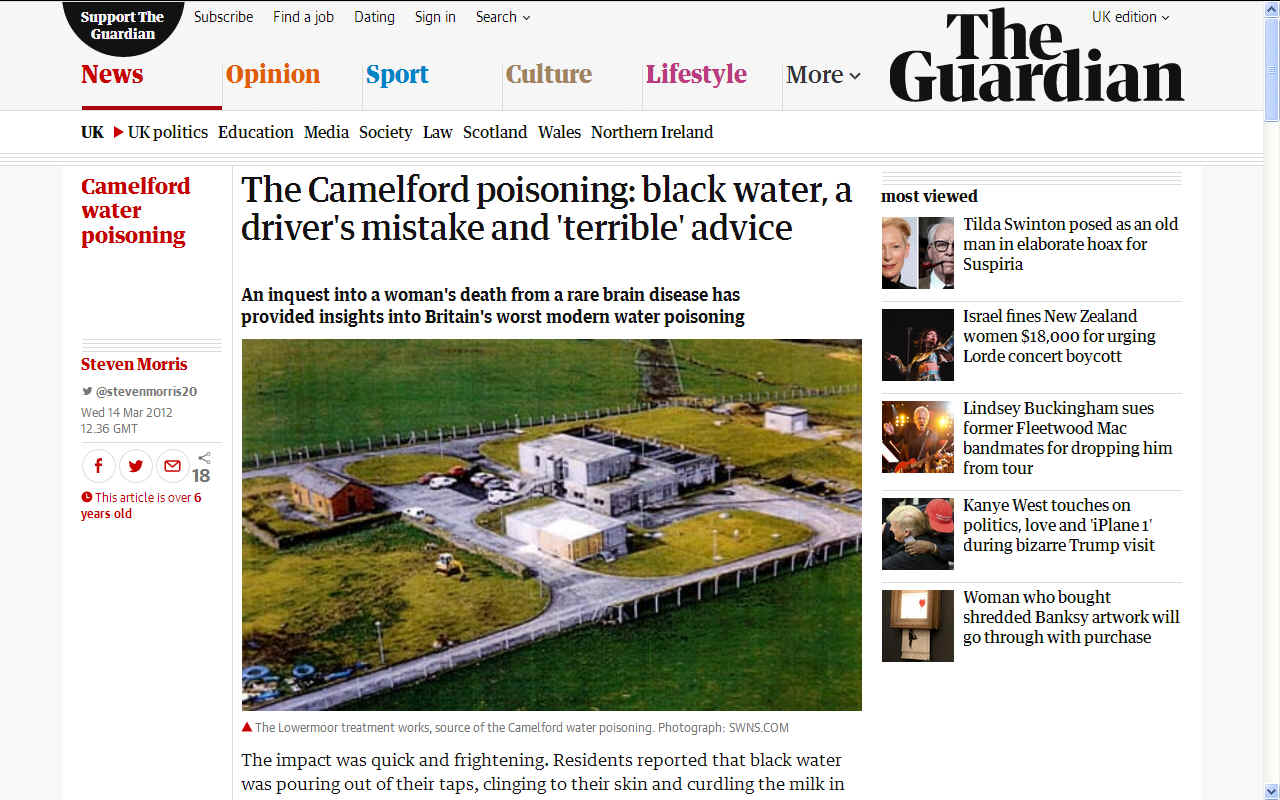
THE
GUARDIAN MARCH 2012 - CAMELFORD, SOMERSET COUNTY COUNCIL, BLACK
WATER POISONING
An inquest into a woman's death from a rare brain disease has provided insights into Britain's worst modern water poisoning.
The impact was quick and frightening. Residents reported that black water was pouring out of their taps, clinging to their skin and curdling the milk in their
tea. One man described how his hair had stuck together after he took a bath, as if his head had been smeared with glue.
Then came the illnesses, as dozens of people who had drunk or bathed in water contaminated after 20 tonnes of
aluminium sulphate was poured into the wrong tank at the local treatment plant complained of conditions including stomach cramps, skin rashes, diarrhoea, mouth ulcers and aching joints.
Almost a quarter of a century on, an inquest into the death of Carole Cross – who died of a rare brain disease after drinking the contaminated water – has again put the spotlight on the Camelford incident and led to questions about the possible long-term impact on those who lived in north Cornwall at the time.
The worst water poisoning in modern British history began with a human error.
Driver John Stephens recalled at Cross's inquest how he had stepped in at the last minute on 6 July 1988 to take over delivery of the aluminium sulphate to the Lowermoor plant, which supplied around 7,000 homes and businesses in and around Camelford. Aluminium sulphate is routinely used early in the treatment of water to clear it of solid particles and was supposed to be held in a storage tank.
Stephens was against the clock. He asked colleagues to telephone to say he would be running late but when he arrived at Lowermoor no one was there. He had been told to put his load "in a tank on the left", but was confused because there were several tanks and manhole covers and he emptied it into the wrong one. The aluminium sulphate flowed into the mains water.
Susan Jones was on duty at the South West Water Authority (SWWA) communications centre when the calls started coming in. Jones told the inquest: "I realised something was seriously wrong when I got a call from a woman whose husband had got out of the bath and his hair was sticking together like Super Glue and I knew it was extremely serious.
"Calls were heightening in numbers. They were coming in at a fantastic rate, too fast to log them all. Water was sticking to people, curdling milk in tea and appearing absolutely black."
She told the inquest she did not feel her bosses were listening to her and she was instructed simply to reassure callers. "I felt I was banging my head against a brick wall," she said. "Nobody seemed to be listening. I asked how I should answer people who wanted to know if it was safe and I was told it was safe to drink. I was told there was no health risk."
On 8 July it was noticed that the level in the aluminium sulphate storage tank was low and Stephens's mistake was spotted. Stephens said when he returned to help explain what had happened, an engineer told him not to talk about it. "Just as we were leaving, he told me he didn't want this to go any further about the aluminium being put in the wrong tank. He said they would sort it out," said Stephens.
Inevitably, the news of the contamination did eventually emerge and, naturally, people wanted to know if they faced a lifetime of health problems.
In 1989 the Conservative government established an independent expert panel, the Lowermoor incident health advisory group. It concluded: "Increased absorption of aluminium may have occurred in some individuals who persisted in drinking the heavily contaminated water. However, all the available evidence suggests that such increases would have been transient, with most of the aluminium being excreted rapidly and only trace amounts being deposited in tissue, chiefly bone."
In October 1990, pressure from those who continued to attribute health problems to the incident, prompted the advisory group to be reconvened.
This time it stressed: "We still have no doubt that the accident itself and subsequent events have led to real mental and physical suffering in the community." But the group added: "The research reported to us does not provide convincing evidence that harmful accumulation of
aluminium has occurred, nor that there is a greater prevalence of organic abnormalities in the exposed."
In 1991 SWWA was fined £10,000 with £25,000 costs at Exeter crown court for supplying water likely to endanger public health. A group of 148 victims reached out-of-court settlements of up to £10,000 each.
Pressure continued from some within the community – although others wanted to forget about it and get on with their lives. In 2001 the Labour government asked the chief medical officer's advisory committee on toxicity in the environment (COT) to investigate the Lowermoor incident.
The committee concluded: "It is not anticipated that the increased exposure to aluminium would have caused, or would be expected to cause, delayed or persistent harm to health in those who were adults or toddlers at the time of the incident."
But it suggested: "Further studies should be carried out to explore the neuropsychological status of those individuals who consumed the contaminated water," and added: "There is a need for further work on the toxicity of aluminium."
Cross, who was living in Camelford at the time of the poisoning, died at the Musgrove Park hospital in Taunton, Somerset, in 2004, aged 59, after suffering from a rare form of the neurological disease cerebral amyloid angiopathy (CAA), usually associated with Alzheimer's.
Her inquest in Taunton has been a drawn-out, stop-start affair. In 2007 the West Somerset coroner, Michael Rose, asked
police to investigate the oft-repeated claim that the
Conservative government of the day had instigated a cover-up because of fears that the incident could harm water privatisation. No such cover-up was found.
In 2008 the coroner accused the Labour government of not providing financial support for the inquest. He turned to Somerset county council for help to pay for research into possible links between the poisoning and Cross's death.
During the inquest, Professor Chris Exley, a professor of bioinorganic chemistry at Keele
University, criticised the way the authority had handled the poisoning, claiming that when it started giving practical advice – to boil the water – it was the "worst possible".
Exley said: "The advice given at the time was the worst possible advice to give. Boiling the water would have tripled the concentration of aluminium.
"It was absolutely terrible advice. I don't think anyone was given any good advice. It is utterly beyond belief and it cannot be acceptable."
He said Cross's brain contained a greater amount of aluminium than any he had examined during his career. "The amount of aluminium in her brain is of an order rarely seen and only seen previously in cases of aluminium toxicity," he said.
Exley described the amount of aluminium sulphate poured into the water supply as "catastrophic" but said there was not enough evidence to show the aluminium in Cross's brain came from the accident because "inadequate testing" was done at the time.
At least they have heard at first hand and under oath from some of those closely involved in the Camelford poisoning, but those who fear the Camelford poisoning could claim further lives in the future may remain unsatisfied.
By Steven Morris
LINKS
& REFERENCE
https://www.theguardian.com/society/2012/mar/14/camelford-water-poisoning-inquest
http://www.abc.net.au/news/2016-08-17/gastro-outbreak-hits-new-zealand-town/7750344
https://www.thechronicle.com.au/news/explosive-claims-over-dirty-water/2944958/
http://www.chinadaily.com.cn/opinion/2016-04/13/content_24488837.htm
https://www.newsroom.co.nz/2018/09/03/219715/council-manager-makes-legal-threat-over-water-report
http://www.legislation.gov.uk/ukdsi/2009/9780111480816
http://www.hse.gov.uk/corpmanslaughter/
|

















































